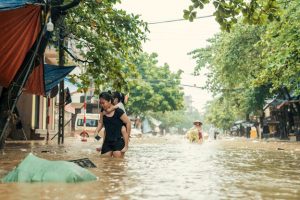Typhoon Yagi Devastates Southeast Asia
 19 September 2024
19 September 2024

The aftermath of Typhoon Yagi in Thai Nguyen, Vietnam. September 11, 2024. Credit: UNICEF/Do Khuong Duy
By Oritro Karim
UNITED NATIONS, Sep 19 2024 (IPS)
In early September, Typhoon Yagi, a deadly tropical cyclone, hit Southeast Asia and Southern China, causing widespread destruction. According to the United Nations (UN), wind speeds, reaching 213 kilometers per hour, as well as heavy flooding and severe landslides, have devastated affected areas. Yagi is the strongest natural disaster to hit the South China Sea in three decades, leaving over 500 people killed, 38 missing, and 1,900 injured.
Officials estimate that 292 people have been killed in Vietnam and over 100 have been killed in Myanmar. A spokesperson for The United Nations Office for the Coordination of Humanitarian Affairs (OCHA), stated that the death toll could be even higher than what was previously reported and that the typhoon has affected over 631,000 people.
The typhoon and subsequent flooding caused considerable damage to critical infrastructures, such as water purification systems, making way for a host of waterborne diseases and widespread water insecurity. The United Nations Children’s Fund (UNICEF) estimates that approximately 400,000 households have been left without access to clean water.
Currently, the World Health Organization (WHO) and UNICEF are on the frontlines of affected areas distributing clean water and water-purification tablets. “Clean water is critical to help prevent food and waterborne disease, and for maintaining safe care and operations at health care facilities, whether it is for people injured in the typhoon and or those needing urgent routine health care”, stated Dr. Angela Pratt, WHO representative for Vietnam.
Additionally, Yagi has caused significant damage to thousands of homes across Southeast Asia. WHO estimates that approximately 130,000 houses have been destroyed as a result of severe flooding. Hundreds of healthcare facilities and schools have been damaged or destroyed as well, with approximately 2 million children in Vietnam alone facing elongated disruptions to their education.
Myanmar, particularly, has seen widespread displacement as a result of this. Myanma Alinn, the government-run newspaper of Myanmar, reports that 438 temporary relief camps have been opened to support the 240,000 people that have been internally displaced.
The Myanmar state disaster response agency informed reporters that extensive flooding has led to road blockages, compromised bridges, and fallen electricity lines, all of which have greatly impeded relief efforts and telecommunications between districts.
Yagi has also caused a great deal of damage to the agricultural systems of the affected regions. The latest reports from the Ministry of Agriculture and Rural Development state that the typhoon had besieged over 97,735 hectares of rice fields. In addition, over 11,746 hectares of vegetables and 6,902 hectares of fruit trees have been damaged. This has overwhelmed Asian farmers, putting them in a state of critical financial jeopardy.
Experts predict that Southeast Asia’s pre-existing concerns of food insecurity are to be greatly exacerbated. Sheela Matthew, the World Food Programme’s (WFP) representative in Myanmar, described the typhoon’s impact on hunger and malnutrition in affected areas as “nothing less than devastating”.
Furthermore, the economy of affected areas have seen significant losses as a result of the typhoon. Strong winds and heavy floods tore into Vietnam’s highly arable Red River Delta, damaging critical manufacturing hubs. According to an initial government assessment, it is estimated that Vietnam has seen losses of up to 1.6 billion dollars.
Currently, the UN and their affiliated organizations are distributing food, drinking water, and hygiene supplies to families in areas that have been hit the hardest. They are also monitoring levels of waterborne diseases for the coming weeks and months. The UN predicts that approximately 994 million dollars will be needed for response efforts. As of now, only 252 million dollars have been raised.
IPS UN Bureau Report
